Buying cellulose ether in bulk can be risky if the quality is not up to standard. Poor product quality can cause construction delays and increase costs. Knowing how to test before buying helps avoid these problems.
Testing cellulose ether quality before bulk purchase involves checking viscosity, substitution degree, moisture content, and purity through laboratory methods. Reliable lab tests and visual inspections reveal product consistency and suitability for construction uses.

Cellulose Ether Quality Test
When purchasing cellulose ether, understanding the key lab tests and common quality issues can protect your investment. Let me guide you through the most important steps to verify quality and what to look out for in bulk orders.
Key Lab Tests for HPMC and Cellulose Ether?
It can be frustrating when the product you receive does not meet your needs, especially after a large order. Without proper testing, you risk using subpar cellulose ether that harms your final product.
Lab tests for HPMC (Hydroxypropyl Methyl Cellulose) and cellulose ether mainly focus on viscosity, degree of substitution, moisture content, pH level, and ash content. These tests ensure the product’s consistency, purity, and performance in applications such as tile adhesive and plaster mortar.
Testing these parameters involves several methods:
| Test Type | What It Measures | Why It Matters |
|---|---|---|
| Viscosity | Thickness and flow of a 2% aqueous solution | Affects workability and water retention |
| Degree of Substitution | Number of hydroxypropyl/methyl groups | Influences solubility and performance |
| Moisture Content | Water percentage in the powder | Excess moisture can cause clumping and decay |
| pH Level | Acidity or alkalinity of solution | Affects stability and compatibility |
| Ash Content | Residue after burning | Indicates purity and presence of impurities |
Viscosity is usually tested at 20°C in a 2% solution. It directly impacts how the cellulose ether will behave in your mix. The degree of substitution affects how well the product dissolves and binds. Moisture content over 5% is often a red flag.
These tests should be performed by a certified lab or your supplier’s quality control department. At KEHAO, we follow strict national standards and use world-class equipment to ensure all parameters are consistent.
Common Quality Issues in Bulk Orders?
Ordering large quantities without testing increases the risk of receiving inconsistent or poor-quality cellulose ether. These problems can cause costly production issues and customer complaints.
Common quality issues include:
- Variations in viscosity: Leading to unpredictable workability and setting times.
- High moisture content: Causing caking, clumping, and shorter shelf life.
- Impurities or fillers: Affecting adhesion and strength.
- Inconsistent particle size: Influencing dispersion and mixing uniformity.
- Unstable pH: Reducing compatibility with other mortar ingredients.

To avoid these issues, insist on a Certificate of Analysis (COA) from your supplier with each shipment. You can also request a sample for independent testing before placing a large order. Visual inspection can help spot moisture problems or contamination.
Here is a checklist to detect common problems:
| Quality Problem | Signs to Watch For | Possible Causes |
|---|---|---|
| Viscosity Variation | Mix too thick or too thin | Poor control in manufacturing |
| High Moisture | Powder lumps or hardens | Inadequate drying or storage |
| Impurities | Color changes, foreign particles | Low-grade raw materials or poor refining |
| Particle Size Issues | Uneven mixing, sedimentation | Inconsistent milling process |
| pH Imbalance | Unexpected reactions or setting behavior | Chemical contamination or improper additives |
Address these problems early with your supplier to ensure consistent performance. At KEHAO, we guarantee uniformity by monitoring all production stages closely.
Reliable Indicators of Good Cellulose Ether?
How can you tell if the cellulose ether you receive is genuinely high quality and fit for your needs? Certain indicators in lab results and physical properties point to a trustworthy product.
Key indicators include:
- Consistent viscosity values matching product specifications.
- Low moisture content below 5% for stability.
- Clear Certificate of Analysis from accredited labs.
- Uniform powder texture without lumps or discoloration.
- Stable pH between 6-8 ensuring chemical compatibility.

Below is a table summarizing good quality criteria versus poor quality signs:
| Quality Indicator | Good Product | Poor Product |
|---|---|---|
| Viscosity (mPa.s) | Within target range ±10% | Fluctuates widely |
| Moisture Content (%) | ≤ 5% | > 5%, leading to caking |
| Appearance | Fine, uniform powder, white/off-white | Lumpy, uneven color, presence of foreign matter |
| pH Level | 6 to 8 | < 6 or > 8 causing incompatibility |
| Certification | COA from national chemical testing center | No reliable certification |
Reliable cellulose ether improves the final product’s water retention, workability, and adhesion. It also prevents common failures like cracking or early drying. At KEHAO, we pride ourselves on strict quality control to deliver this consistency.
Conclusion
Testing cellulose ether quality before bulk purchase protects your project from delays and defects. Use key lab tests, watch for common quality issues, and check reliable indicators to ensure you get the best product.



